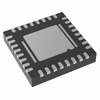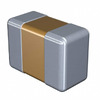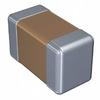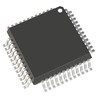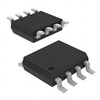HC-06 Bluetooth Module: Applications, Arduino Connection, and Specifications
The HC-06 Bluetooth module is an important part of wireless communication, allowing microcontrollers to share data with other electronic devices over short distances. It's popular because it's easy to use and works well in many projects. This article goes over the main features of the HC-06, including its pins, technical details, different uses, and how to connect it to devices like Arduino boards.Catalog
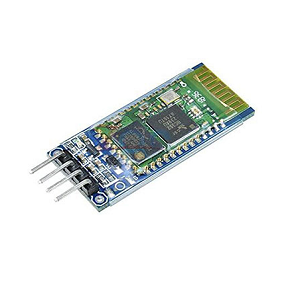
What is the HC-06 Bluetooth Module?
The HC-06 is a module adhering to Bluetooth Version 2.0, crafted to facilitate smooth and efficient wireless serial data exchange. It chiefly functions transparently as a slave device, allowing seamless connectivity with master devices like PCs or smartphones. Its ability to transmit serial data without necessitating extensive programming streamlines wireless communications, drawing interest from anyone aiming to simplify such setups. Renowned for its compact and easy-to-integrate design, the HC-06 module enriches versatility across countless applications. It supports asynchronous serial communication, ensuring reliable data transfer at a standard baud rate. A notable feature is its quick pairing ability, maintaining a stable connection, appealing to those involved in projects that continuously stream data via Bluetooth. The HC-06 finds applications in a spectrum of sectors, from home automation to industrial controls. An illustrative example is its incorporation into a home automation project, enabling to control appliances remotely through a smartphone app, thus emphasizing its role in fostering friendly interfaces and granting a sense of control and efficiency.
HC-06 Pin Configuration
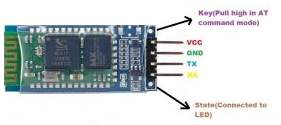
| Pin No |
Pin Name |
Function |
|
1 |
Key |
The pin state determines whether the module works in AT
command mode or normal mode [High=AT commands receiving mode (Commands
response mode), Low or NC=Bluetooth module normally working] |
|
2 |
Vcc |
'+5V Positive supply needs to be given to this pin for
powering the module |
|
3 |
Gnd |
Connect to ground |
|
4 |
TXD |
Serial data is transmitted by module through this pin (at
9600bps by default), 3.3V logic |
|
5 |
RXD |
Serial data is received by module through this pin (at
9600bps by default), 3.3V logic |
|
6 |
State |
The pin is connected to the LED on the board to represent
the state of the module |
Features of the HC-06
Power Dynamics and Range of Operation
The HC-06 module performs at a Class 2 power level, achieving a harmonious range that suits a variety of applications. Operating voltages span from 3.3V to 6V, allowing it to seamlessly integrate into diverse electronic systems. This flexibility opens opportunities for its use across various environments without being hindered by notable voltage challenges. Additionally, it operates reliably in temperatures from -20ºC to +55ºC, ensuring stable performance indoors and in mild outdoor settings. In many practical applications, even if temperatures slightly vary, the module maintains its efficiency, emphasizing its resilient operational blueprint.
Modulation Techniques and Safeguards
Employing Gaussian Frequency Shift Keying (GFSK) for modulation, the HC-06 enhances data transmission reliability by adeptly handling frequency deviations, mitigating interference and noise. The module is equipped with robust security measures like authentication and encryption, nurturing a secure communication environment. This shield against unauthorized access and potential data breaches suits contemporary wireless communication demands, where data integrity and confidentiality are required.
Energy Consumption
During standard operations, the module draws approximately 40mA. This restrained current usage makes the HC-06 an attractive option for designs conscious of energy use, particularly in battery-operated devices. The module’s reliable power needs simplify design trajectories, facilitating meticulous power allocation and effective resource control.
HC-06 Technical Specifications
Technical characteristics and components of the HC-06, along with parts comparable to the Amphenol Anytek HC06B0500000G.
|
Type |
Parameter |
|
Factory Lead Time |
10 Weeks |
|
Housing Material |
Thermoplastic |
|
Operating Temperature |
-40°C~115°C |
|
Series |
HC |
|
Moisture Sensitivity Level (MSL) |
1 (Unlimited) |
|
Pitch |
0.146 3.70mm |
|
Voltage |
300V |
|
Current |
2A |
|
Positions Per Level |
6 |
|
Wire Termination |
Screwless - Push Button Clamp |
|
Mounting Type |
Through Hole, Kinked Pin |
|
Contact Material - Plating |
Phosphor Bronze - Tin Plated |
|
Packaging |
Bulk |
|
Part Status |
Active |
|
Color |
Green |
|
Wire Gauge |
20-26 AWG |
|
Number of Levels |
1 |
|
Terminal and Terminal Block Type |
BARRIER STRIP TERMINAL BLOCK |
|
Mating Orientation |
45° (135°) Angle with Board |
|
RoHS Status |
Non-RoHS Compliant |
Alternatives of the HC-06
• HC-04
• HC-02
• HC-05
• HC-03
Benefits of Utilizing HC-06
Economic Viability and Effective Range
The HC-06 module offers an impressively economical option for short-range wireless communication, for distances under 100 meters. It combines affordability with commendable performance, making it appealing for projects constrained by financial limits. Its capability to sustain steady connections within this range is valuable for diverse applications such as home automation and industrial control systems. The module demonstrates how budget-friendly options can meet technological needs without sacrificing quality.
Power Efficiency
Another benefit of the HC-06 is its power efficiency, which appeals to systems that rely on battery power or need portability. This feature ensures extended operation periods without the necessity for frequent battery changes, thereby easing maintenance tasks. In practical scenarios like wearable technology, where battery longevity is a primary concern, the module's energy-saving attributes fit well with the goal of creating environmentally considerate technologies, promoting sustainable practices.
Effortless UART Interface Connectivity
The HC-06 comes equipped with a UART interface that simplifies connectivity with a myriad of controllers and processors. This friendly integration enables to invest their time and energy into honing the functions of projects rather than grappling with intricate connectivity hurdles. Supported by numerous development platforms, the HC-06 facilitates smoother phases of prototyping and implementation. This compatibility proves advantageous in practical applications, such as smart home systems, where swift deployment is often a necessity.
Ease of Integration
The integration process of the HC-06 into various wireless configurations is uncomplicated, notably reducing both the time and complexity associated with design workflows. Its broad compatibility with numerous microcontrollers and devices plays a role in optimizing development cycles. Moreover, due to its straightforward integration, the module is widely used in educational environments to teach the wireless communication.
Applications for HC-06
Bluetooth-Enhanced Automotive Systems
In the automotive sector, HC-06 modules create flawless connectivity for Bluetooth-enabled vehicle devices. They improve in-car communication systems, enabling functions such as hands-free calling, music streaming, and navigation integration. The incorporation of these modules enriches the driving experience, allowing drivers to interact effortlessly with vehicle systems, all the while maintaining focus on the road.
GPS Integration and Optimization
When integrated with GPS systems, HC-06 modules ensure data exchange between devices and GPS units. This supports precise location tracking and navigation in various contexts, from managing fleets to planning outdoor adventures. By simplifying communication with smartphones or tablets, these modules revolutionize the handling and interpretation of geographical data.
Robotics and Wireless Control Systems
HC-06 modules are use in robotics for creating wireless control frameworks. They enable remote operations and data interchange between robots and controllers, driving forward advancements in automation and the education of robotics. By establishing strong communication interfaces, these modules allow for the execution of complex tasks and functions in robotic applications.
Wireless Computer Peripherals
As wireless technology expands, HC-06 is frequently used to develop Bluetooth-compatible computer peripherals such as keyboards, mice, and printers. This module streamlines the process of device connectivity without relying on physical cables, promoting organized and efficient work environments. Its role in this area emphasizes the evolution towards a more interconnected, cable-free digital space.
Solutions for Data Transfer
HC-06 modules serve as reliable elements for wireless data transfer in systems requiring short-range communication, like data logging and telemetry. They enable smooth data exchanges absent of cumbersome wiring, proving beneficial in industrial and environmental monitoring systems where fluid data flow is important.
Leisure and Entertainment Gadgets
In leisure electronics, the HC-06 module empowers devices like Bluetooth speakers, gaming consoles, and remote-controlled toys with wireless features. Others gain a more interactive and mobile experience, enhancing activities such as gaming, music listening, or engaging in recreational pursuits.
Arduino Connection of the HC-06
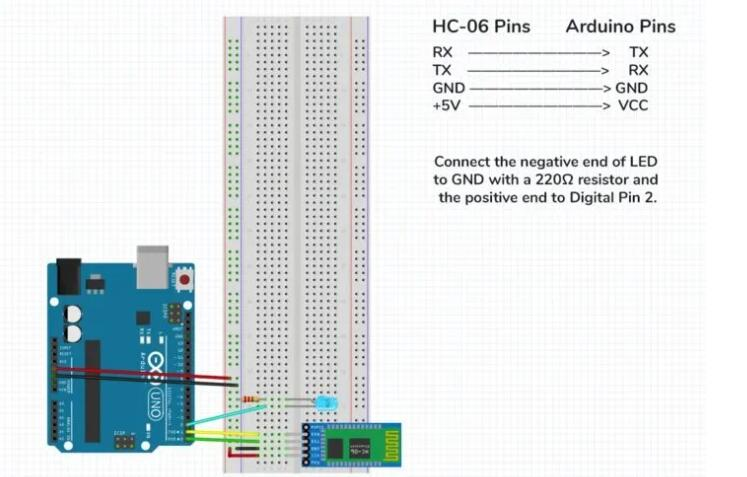
To connect the HC-06 Bluetooth module to an Arduino UNO, you'll need to link a few important pins between the two. First, power the HC-06 by connecting its VCC pin to the 5V pin on the Arduino, which supplies the module with the necessary power. Next, connect the GND pin (ground) on the HC-06 to the GND pin on the Arduino. This establishes a common ground, which is important for stable communication between the devices. Now, set up serial communication between the two. The HC-06 uses two main pins for data transmission and reception, labeled RXD and TXD. Connect the TXD pin on the HC-06 to the RX pin on the Arduino so that the Arduino can receive data from the HC-06. Then, connect the RXD pin on the HC-06 to the TX pin on the Arduino so the Arduino can send data to the module. However, since the HC-06’s RXD pin only supports 3.3V and the Arduino outputs 5V, you’ll need to use a voltage divider (typically a pair of resistors) between the Arduino’s TX pin and the HC-06’s RXD pin to avoid damaging the module. Following these steps will allow your HC-06 to communicate reliably with the Arduino.
Using the HC-06 Bluetooth Module with Arduino
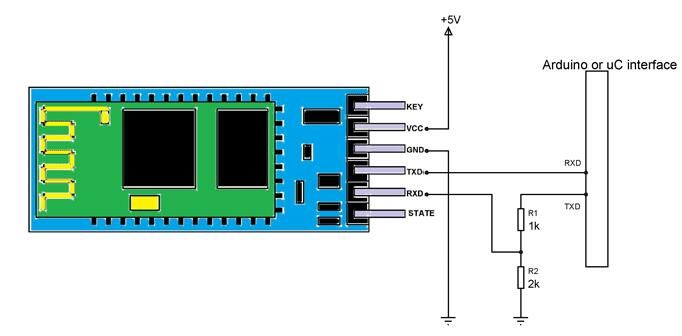
To send and receive data with the HC-06, you'll use a connection type called UART (Universal Asynchronous Receiver-Transmitter), which enables the Arduino and the HC-06 to exchange messages. First, make sure the HC-06 module is connected to a 5V power source to ensure it has enough power to function correctly. Next, set up the UART connections by linking the Arduino's RX pin to the HC-06's TXD pin and the Arduino's TX pin to the HC-06's RXD pin. Be sure to use a resistor voltage divider on this connection to reduce the voltage from 5V to a safer 3.3V level for the HC-06. If your Arduino and HC-06 are using separate power sources, connect their ground (GND) pins together to establish a shared ground, for accurate communication. Once all connections are in place, you can program the Arduino through the Arduino IDE to communicate with the HC-06, enabling you to control the module and reliably send or receive data.
Differences Between HC-06 and HC-05
Both HC-06 and HC-05 modules facilitate wireless serial communication, enabling efficient and effortless data exchange. The HC-05 module can function as either a master or slave, broadening its application across various innovative uses. This capability provides an edge in applications demanding adaptability. On the other hand, the HC-06 operates exclusively as a slave, offering a more straightforward path ideal for scenarios prioritizing simplicity and ease of integration, such as basic sensor data transmission or uncomplicated Bluetooth projects. The HC-05 is noted for its adaptability, as it can independently initiate connections, which is advantageous for sophisticated Bluetooth networks where multiple devices connect in dynamic patterns. This ability fuels scenarios like automation systems and complex IoT environments, enabling automatic connectivity without intervention. Conversely, the HC-06 simplifies its role by only accepting connections, confining its utility to situations where ongoing active connections are unnecessary. It is a great choice for fixed setups where connections are predetermined and static. The HC-05 is a popular choice in smart home ecosystems, where it acts as a central hub, adept at controlling numerous devices through multiple connections. In contrast, the HC-06 is suitable for single-connection projects, such as basic wireless communication tasks within home automation systems, where user engagement is minimal. The consideration here is balancing the simplicity of implementation with the complexity required for functional enrichment based on project objectives.
HC-06 Module Dimensions

HC-06 Manufacturer Information
Founded in the vibrant technological landscape of Taiwan in 1997, Amphenol Anytek has carved out a distinct reputation in the electronic components manufacturing field. The organization is acclaimed for its superior production capabilities, as demonstrated by products like the HC-06. Leveraging a deep well of internal expertise, Anytek maintains rigorous production standards that echo a deep-seated commitment to excellence. The company's expansive R&D facilities mirror its pursuit of innovative technological breakthroughs, a dedication that not only upholds high production standards but also enables swift adaptation to evolving technological trends and market shifts. Anytek enjoys a unique vantage point for observing global electronics trends. This geographical position allows the company to tap into leading-edge technological developments and industry-leading practices. The blend of location-derived insights and internal innovative strength facilitates Anytek not only in keeping stride with international competitors but also in setting new industry benchmarks. Amidst the swiftly transforming technological environment, this balanced approach, combining innovation with regional strengths, can decisively sustain its leadership and influence in the industry.
About us
ALLELCO LIMITED
Read more
Quick inquiry
Please send an inquiry, we will respond immediately.
Frequently Asked Questions [FAQ]
1. What is the HC-06 designed for?
The HC-06 Bluetooth module acts as an exclusive slave device, crafted for smooth wireless serial communication. It simplifies data exchange between digital devices like microcontrollers and modern smart gadgets, playing a supportive role in applications such as home automation and embedded systems. This module's capability to fit effortlessly into existing setups enhances its appeal in today's tech-focused environments.
2. How does the HC-06 Bluetooth module function?
The HC-06 operates as a class 2 slave Bluetooth module, created for seamless wireless serial communication. Once linked with a master Bluetooth device, such as a computer, smartphone, or tablet, its activities become effortlessly transparent to the user. It swiftly transmits serial data via wireless connections. This operational model reduces complexities in digital device integration, optimizing tasks requiring wireless engagement. Application and electronics enthusiasts appreciate the module’s straightforward process, which speeds up project timelines while maintaining communication performance.
3. What is the range capability of the HC-06 Bluetooth module?
The HC-06 module, akin to the HC-05, supports a connectivity span up to 9 meters (30 feet). This range suffices for personal networking needs, enabling tasks from sensor data collection to remote device management. For those in limited or residential spaces, this span generally addresses their operational needs without necessitating signal amplification or range extension techniques. When selecting a module for projects, it’s wise to consider possible obstacles and electromagnetic disruptions that might affect performance in practical use.
4. How are HC-05 and HC-06 distinct from each other?
The core difference between HC-05 and HC-06 lies in their operational versatility: HC-05 functions as both master and slave, while HC-06 is limited to slave mode. This difference is dictated by their firmware, with HC-05 offering broader adaptability for applications needing role transitions, a beneficial trait in complex network configurations. On the other hand, HC-06, with its singular focus, streamlines deployment for straightforward applications, supporting in achieving a more efficient system structure.
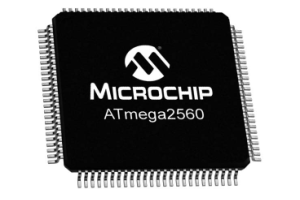
Exploring the ATMEGA2560 Microcontroller
on November 12th

All About the TIP122 Transistor: Datasheet, Dimensions, and Circuit Uses
on November 12th
Popular Posts
-

What is GND in the circuit?
on January 1th 3160
-

RJ-45 Connector Guide: RJ-45 Connector Color Codes, Wiring Schemes, R-J45 Applications, RJ-45 Datasheets
on January 1th 2725
-

Understanding Power Supply Voltages in Electronics VCC, VDD, VEE, VSS, and GND
on November 16th 2339
-

Fiber Connector Types: SC Vs LC And LC Vs MTP
on January 1th 2207
-

Comparison Between DB9 and RS232
on January 1th 1825
-

What Is An LR44 Battery?
Electricity, that ubiquitous force, quietly permeates every aspect of our daily lives, from trivial gadgets to life-threatening medical equipment, it plays a silent role. However, truly grasping this energy, especially how to store and efficiently output it, is no easy task. It is against this background that this article will focus on a type of coin cell battery that may seem insignificant on the...on January 1th 1797
-

Understanding the Fundamentals:Inductance Resistance, andCapacitance
In the intricate dance of electrical engineering, a trio of fundamental elements takes center stage: inductance, resistance, and capacitance. Each bears unique traits that dictate the dynamic rhythms of electronic circuits. Here, we embark on a journey to decipher the complexities of these components, to uncover their distinct roles and practical uses within the vast electrical orchestra. Inductan...on January 1th 1753
-

CR2430 Battery Comprehensive Guide: Specifications, Applications and Comparison to CR2032 Batteries
What is CR2430 battery ?Benefits of CR2430 BatteriesNormCR2430 Battery ApplicationsCR2430 EquivalentCR2430 VS CR2032Battery CR2430 SizeWhat to look for when buying the CR2430 and equivalentsData Sheet PDFFrequently Asked Questions Batteries are the heart of small electronic devices. Among the many types available, coin cells play a crucial role, commonly found in calculators, remote controls, and ...on January 1th 1718
-

What Is RF and Why Do We Use It?
Radio Frequency (RF) technology is a key part of modern wireless communication, enabling data transmission over long distances without physical connections. This article delves into the basics of RF, explaining how electromagnetic radiation (EMR) makes RF communication possible. We will explore the principles of EMR, the creation and control of RF signals, and their wide-ranging uses. The article ...on January 1th 1709
-

Comprehensive guide to hFE in transistors
Transistors are crucial components in modern electronic devices, enabling signal amplification and control. This article delves into the knowledge surrounding hFE, including how to select a transistor's hFE value, how to find hFE, and the gain of different types of transistors. Through our exploration of hFE, we gain a deeper understanding of how transistors work and their role in electronic circu...on November 16th 1676
